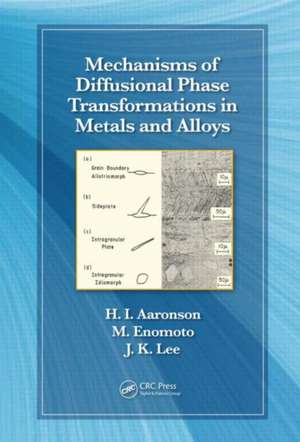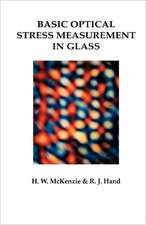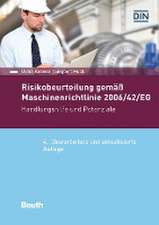Mechanisms of Diffusional Phase Transformations in Metals and Alloys
Autor Hubert I. Aaronson, Masato Enomoto, Jong K. Leeen Limba Engleză Hardback – 19 mai 2010
Mechanisms of Diffusional Phase Transformations in Metals and Alloys is devoted to solid-solid phase transformations in which elementary atomic processes are diffusional jumps, and these processes occur in a series of so-called nucleation and growth through interface migration. Instead of relying strictly on a pedagogical approach, it documents the evolution of phase transformation concepts. The authors present topics by describing a phenomenon and then following up with a corresponding hypothesis or alternative explanation. In this way, the book also shows how the field continues to evolve and meet new challenges.
Integrated with information from a number of key papers and review articles, this volume reflects this revered and influential instructor’s unique and passionate way of introducing well-established theories and knowledge in a systematic way, at the same time introducing, in great detail, how a new idea or interpretation of a phenomenon has emerged, evolved, and gained its current status. If the published version of a theory or a model was too condensed, Aaronson worked the problem out in painstaking detail so that graduate students could follow the derivations. This collection is full of such unique "Aaronsonian idiosyncrasies," which add immense value as a powerful tool for learning in this challenging materials field.
Preț: 752.70 lei
Preț vechi: 1074.70 lei
-30% Nou
Puncte Express: 1129
Preț estimativ în valută:
144.05€ • 149.83$ • 118.92£
144.05€ • 149.83$ • 118.92£
Carte tipărită la comandă
Livrare economică 14-28 aprilie
Preluare comenzi: 021 569.72.76
Specificații
ISBN-13: 9781420062991
ISBN-10: 1420062999
Pagini: 686
Ilustrații: 581 b/w images, 36 tables and 1300-1500 equations
Dimensiuni: 178 x 254 x 41 mm
Greutate: 1.36 kg
Ediția:1
Editura: CRC Press
Colecția CRC Press
ISBN-10: 1420062999
Pagini: 686
Ilustrații: 581 b/w images, 36 tables and 1300-1500 equations
Dimensiuni: 178 x 254 x 41 mm
Greutate: 1.36 kg
Ediția:1
Editura: CRC Press
Colecția CRC Press
Public țintă
UndergraduateCuprins
Applied Thermodynamics. Diffusional Nucleation in Solid–Solid Transformations. Diffusional Growth. Precipitation. Massive Transformation. Cellular Reaction. Pearlite Reaction. Martensitic Transformations. Bainite Reaction and Role of Shear in Diffusional Phase Transformations. References. Index.
Notă biografică
Hubert Irwin Aaronson (Hub) received his BS, MS, and Ph.D. in metallurgical engineering at Carnegie Institute of Technology, Pittsburgh, Pennsylvania (now Carnegie Mellon University). He was a worldwide leader in the field of phase transformations of metals and alloys for more than half a century. He published more than 300 technical papers, organized numerous symposia and conferences, served a number of technical committees, and was recognized with many awards. He was a member of the U.S. National Academy of Engineering, Washington, District of Columbia; a fellow of both The Minerals, Metals and Material Society and ASM International; and an honorary member of the Japan Institute of Metals, Sendai, Japan. As R.F. Mehl Professor Emeritus at Carnegie Mellon University, Hub continued his professional activities to the very end until his passing in December 2005.
Masato Enomoto received his BS and MS in physics from Tokyo University, and his Ph.D. from Carnegie Mellon University, Pittsburgh, Pennsylvania. He received many honors and awards both in the United States and in Japan for his research on phase transformations in metallic materials. He authored a book, Phase Transformations in Metals, in Japanese, and served on the editorial boards of several technical journals, including ISIJ International as editor-in-chief. He was elected a fellow of ASM International. He is currently a professor of materials science and engineering, Ibaraki University, Hitachi City, Japan.
Jong K. Lee received his BS from Seoul National University, Seoul, South Korea; his MS from the University of Washington, Seattle; and his Ph.D. from Stanford University, California. He taught at Michigan Technological University, Houghton, for over three decades. He is a fellow of ASM International, and a foreign member of both the Korean Academy of Science and Technology and the National Academy of Engineering of Korea. He continues his research activities as a professor emeritus and research professor at the Department of Materials Science and Engineering, Michigan Technological University.
Masato Enomoto received his BS and MS in physics from Tokyo University, and his Ph.D. from Carnegie Mellon University, Pittsburgh, Pennsylvania. He received many honors and awards both in the United States and in Japan for his research on phase transformations in metallic materials. He authored a book, Phase Transformations in Metals, in Japanese, and served on the editorial boards of several technical journals, including ISIJ International as editor-in-chief. He was elected a fellow of ASM International. He is currently a professor of materials science and engineering, Ibaraki University, Hitachi City, Japan.
Jong K. Lee received his BS from Seoul National University, Seoul, South Korea; his MS from the University of Washington, Seattle; and his Ph.D. from Stanford University, California. He taught at Michigan Technological University, Houghton, for over three decades. He is a fellow of ASM International, and a foreign member of both the Korean Academy of Science and Technology and the National Academy of Engineering of Korea. He continues his research activities as a professor emeritus and research professor at the Department of Materials Science and Engineering, Michigan Technological University.
Descriere
Based on the lecture notes of the renowned Hubert I. Aaronson, this text details the fundamental principles of phase transformations in metals and alloys upon which steel and other metals industries are based. Instead of relying strictly on a pedagogical approach, it documents the evolution of phase transformation concepts, demonstrating how the field continues to meet new challenges. The authors present topics by describing a phenomenon and then following up with a corresponding hypothesis or alternative explanation.





